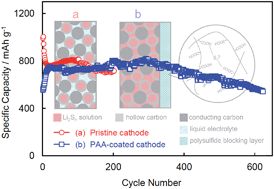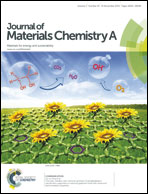Poly(acrylic acid) gel as a polysulphide blocking layer for high-performance lithium/sulphur battery
Abstract
The lithium/sulphur (Li/S) battery is one of the most promising electrochemical energy storage systems after the Li ion battery, due to the high theoretical energy density and low cost of elemental sulphur. However, its development has been hindered by many problems in relation to the out-diffusion of dissolved lithium polysulphide (PS, Li2Sn with 4 ≤ n ≤ 8), the series of sulphur reduction intermediates. In this paper we demonstrate a proof of concept for blocking the out-diffusion of the dissolved PS by employing a dual-layer structural sulphur cathode with a porous poly(acrylic acid) (PAA) membrane coated on the top surface. Upon activation with the liquid electrolyte, the porous PAA membrane becomes a gel and the resulting gel chemically blocks the out-diffusion of PS anions by forming hydrogen bonds between the COOH groups in the gelled PAA and the negatively charged PS anions. Verified visually by a potentiostatic polarization experiment at 1.7 V vs. Li/Li+, the out-diffusion of PS in an electrolyte-flooded Li/S cell is effectively blocked by the dual-layer structural sulphur cathode. As a result, the Li/S cell consisting of a dual-layer structural sulphur cathode exhibits much improved capacity retention while still providing a similar specific capacity, as compared with the cell using the conventional sulphur cathode.


 Please wait while we load your content...
Please wait while we load your content...